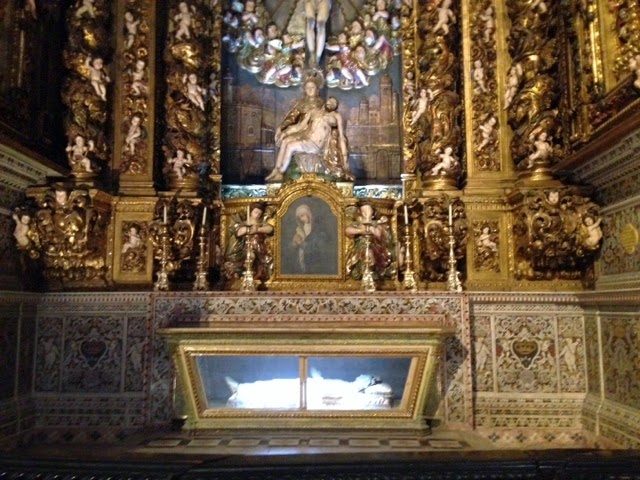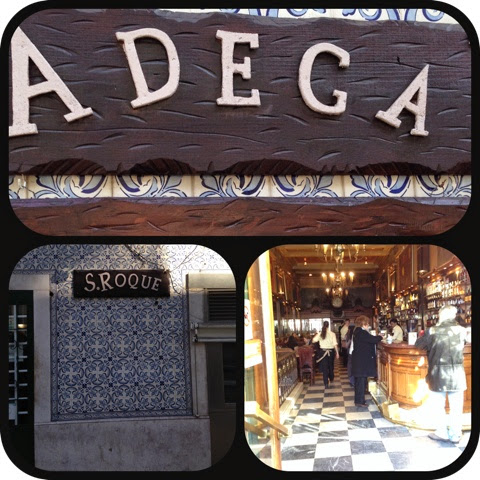 As you get off the elevator there is a restaurant which has a bautiful view of the city and then this walkway takes you to the Bairro Alto District.
As you get off the elevator there is a restaurant which has a bautiful view of the city and then this walkway takes you to the Bairro Alto District.The Igreja do Carmo is the small Archaeologicall Museum which house artifacts from ancient Portuguese history.. Previously it had been a church and convent for the Carmelite Order and was founded by a Portuguese knight in 1389. In 1404, after helping to secure Portugal's independence from Spain the knight, Nuno Alvares Periera donated his entire wealth and became a full brother in 1423. On the 1st of November 1775, Lisbon was ravaged by a massive earthquakke. The 1st of November is also the feast of "All Saints" and the worshippers celebrating the festival filled the church. The 8.9 earthquake rocked the church and the huge roof collapsed crushing hundreds of worshippers. The arches which supported that roof are stil visible today. The church survivied the tsunami but the candles lit for the celebration toppled and burned. The convent and church are two permanent reminders of the horrors that faced Lisbon during the devastation. I read that they estimate 90,000 people lost their life during that earthquake, tsunami, and fire.
It was converted to a wood store and then in 1864 it was donated to the Association of Portuguese Archaeologists. The church was transformed into a museum and the Carmo Convent was rebuilt by the military and the complex became a central base for the army.
We decided to just walk around and see what we could see. We saw this very interesting looking theater and then stumbled upon the church and museum of Sao Roque. Sharon had read about the church and although very unimpressive when you look at the exterior she remembered that the chapels in the church were supposed to be quite something. As we approached to go in we were told a service was going on but to come back in 30 minutes or so and we were encouraged to go see the mueum during that time. Most museums are free on Sunday so it was in our price range.
A little bit about Saint Roch, he was born at Montpellier towards 1295; died 1327. His father was governor of that city. At his birth St. Roch is said to have been found miraculously marked on the breast with a red cross. Deprived of his parents when about twenty years old, he distributed his fortune among the poor, handed over to his uncle the government of Montpellier, and in the disguise of a mendicant pilgrim, set out for Italy, but stopped at Aquapendente, which was stricken by the plague, and devoted himself to the plague-stricken, curing them with the sign of the cross. He next visitedCesena and other neighbouring cities and then Rome. Everywhere the terrible scourge disappeared before his miraculous power. He visited Mantua, Modena,Parma, and other cities with the same results. At Piacenza, he himself was stricken with the plague. He withdrew to a hut in the neighbouring forest, where his wants were supplied by a gentleman named Gothard, who by a miraclelearned the place of his retreat. After his recovery Roch returned to France. Arriving at Montpellier and refusing to disclose his identity, he was taken for a spy in the disguise of a pilgrim, and cast into prison by order of the governor, — his own uncle, some writers say, — where five years later he died. The miraculous cross on his breast as well as a document found in his possession now served for his identification. He was accordingly given a public funeral, and numerousmiracles attested his sanctity.
With the outbreak of the plaque in Lisbon King Manuel I asked the Republic of Venice for a relic of Saint Roch. A shrine was built to host the relic and and gathered little importance until the latter half of the 16th century when the chapel became a gathering location for the Society of Jesus (Jesuit) which followed the philosphy of the Catholic Counter-Reformation. The devotion and money of the society tranformed the humble shrine into one of the most significant and decorative churches in Lisbon.
The next group of pictures were taken in the museum.
These panals depict the life and legend of the Saint.
This is the Reliquary-ark of Saint John de Brioto.
A number of Saints.
We left th museum which had taken us longer then 30 minutes to get through but the service was till in session so our friendly security guy told us to walk 2 minutes up the street and we would come to a lovely Miradouro. We did and it was. The entire name is the Miradouro de Sao Pedro de Alcantara.
 Just down from the terrace was this lovely garden area. It really doesn't look too nice in the picture but looked lovey that day and I'm sure in the summer it is just beautiful.
Just down from the terrace was this lovely garden area. It really doesn't look too nice in the picture but looked lovey that day and I'm sure in the summer it is just beautiful.This is the bust of a newspaper magnate and below him is the statue of a newspaper delivery boy.
There was a little coutyard restaurant so we decided to give the service plenty of time and we'd pass that time eating!
 Sharon orderd a chicken pie appetizer. They were small but very filling - like an empanada but shaped differently.
Sharon orderd a chicken pie appetizer. They were small but very filling - like an empanada but shaped differently.I had a little glass of wine while Sharon ate and we waited for my chicken curry sandwich. I was trying to mellow out after losing my entire first day blog to the trash bin. By this time I had actually decided I needed to get over it and enjoy the day! I asked the waiter to take our picture and he was so nice - he took two different angles.
While we were sitting there enjoying our lunch the waiter went by. Yes, that is a bottle of Matteus on that tray, JoAnne.
 We passed this funicular on our way to and from the church. Just another way to get to the top of the hill. I read one of the trip advisor reviews and someone refused to pay his 1.25 to ride in a grafitti covered old tram. It is known as the Elevador da Gloria. It opened on 24 October, 1885. There are two other funiculars in Lisbon but this one is the busiest and most accessible . It operates from 0700 - 0055 everyday.
We passed this funicular on our way to and from the church. Just another way to get to the top of the hill. I read one of the trip advisor reviews and someone refused to pay his 1.25 to ride in a grafitti covered old tram. It is known as the Elevador da Gloria. It opened on 24 October, 1885. There are two other funiculars in Lisbon but this one is the busiest and most accessible . It operates from 0700 - 0055 everyday.Finally the service was over and we were able to get into the church. It is unbelievable! You walk in and you are actually stunned by its beauty.
But the chapels are something else. The church was comstructed in complance with the rules of the
Society of Jesus and with the liturgical recommendations of the Council of Trent, and thus was representative of the process of the renovation of the Roman Catholic faith in agreement with the Tridentine doctrine. Of rectangular layout, with a single main nave, a shallow chancel and eight side chapels, in architectural terms it can be describef as a "hall church". The exuberant ornamentation of the interior is the result of different decoration campaigns promoted not only by the society of Jesus itself and the Santa Casa da Misericordia de Lisbon but also by the Portuguese Crown, and the religious brotherhoods and confraternities based in the church, which assumed responsibiity for the decoration of specific side chapels. The church contains some valuable sacred relics - a thorn from the crown of thorns and a piece of wood from Jesus's crib.
Three of the chapels featured below.
The following is the chapel of Saint John the Babtist. This chapel was ordered by King John V and designed by the Italian architect Luigi Vanvitelli and Nicola Salvi. Inaugurated in 1752, this chapel differs from the rest of the church because of the use of different types of stone (preious and semi-precious) and gilt bronze in its drcorations, a common feature in the Romam Baroque. Its construction took place in Rome between 1742 - 1747 and it was transported to Portugal in three shipments and assembled in the Church of Sao Roque. It is the most expensive chapel in Europe.
The floor is a mosaic.
We were very fortunate that one of the young men working in the church that day let us into the sacristy. It was not open to the public on this pparticular day. It was built at the beginning of the 17th century. The large chests are made of jacaranda and rosewood with inlaid ivory. The highlight in the room as far as paintings is concerned is the set of twenty scenes on the life and legend of St. Francis Xavier by Andre Reinoso above the chest of drawers. We were not able to stay in the room very long so the pictures were taken quickly without really being able to study what I was taking pictures of.
We left the church and walked through the Chiado and Bairro Alto Districts making discoveries as we walked along.
 Thiss is a statue of a friendly lottery-ticket salesman. Two lottery kiosks are nearby. Locals who buy in to the ottery bur the statue's tickets for good luck.
Thiss is a statue of a friendly lottery-ticket salesman. Two lottery kiosks are nearby. Locals who buy in to the ottery bur the statue's tickets for good luck.It was Sunday - so we went into another church - just a brief visit.
and we found this wonderful area where families just hang out. There are little kiosks where you can get drinks and snacks. There's a play area for kids, intresting fountains, and music playing.
We looked for a rooftop bar that we had read about because we thought at this point we could use a little glass of wine perhaps. We finally found the hotel but the rooftop bar and restaurant was not open on Sunday. We decided to go home and have a glass of wine and eat the left over chili we had made the night before. We were tired!






































































No comments :
Post a Comment